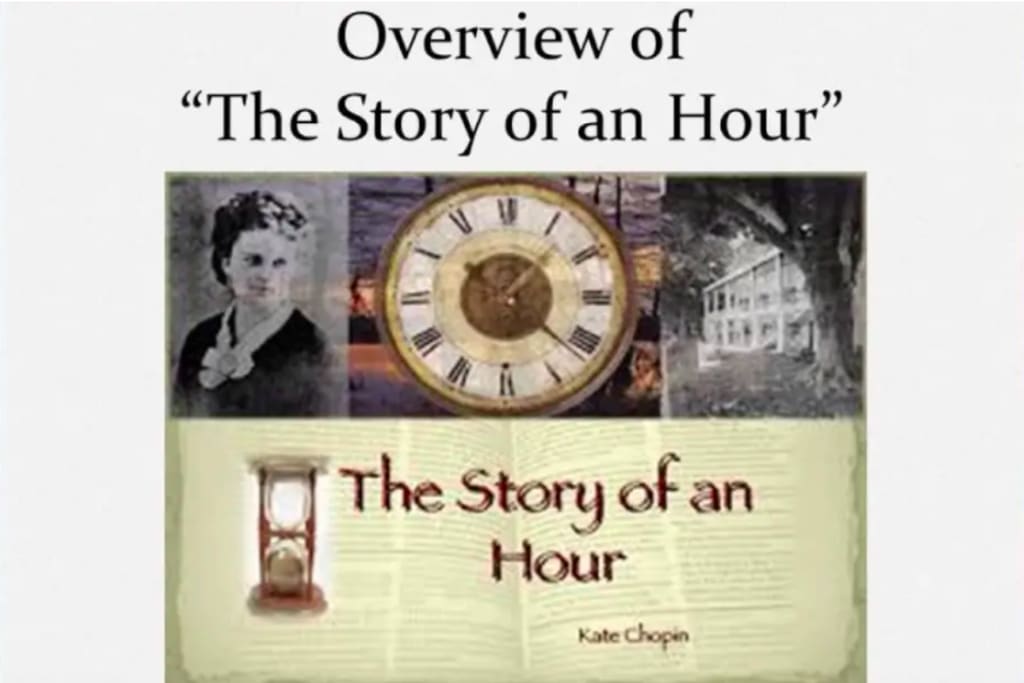'The Story of an Hour'
Gender and Patriarchy

The Story of an Hour is a short story published by Kate Chopin in 1800s. The story is set on the protagonist, Louis Mallard and her marriage with Brently Mallard that shapes much of the story later on. The story unfolds after Louis hears about the death of her husband in a train accident. She is informed of this tragic news by her sister, Josephine. Upon hearing this, Louis is devastated and promptly rushes upstairs to her room where she locks herself up. Louise takes a seat and watches out an open window. She sees trees, smells drawing nearer rain, and hears a seller shouting out what he's offering. She hears somebody singing and also the hints of sparrows, and there are fleecy white mists in the sky. She is youthful, with lines around her eyes. As yet crying, she looks into the separation. She feels uneasy and tries to smother the building feelings inside of her, yet can't. She starts rehashing the word "free" to herself again and again. Her heart thumps rapidly, and she feels warm.
Louise knows she will cry again when she sees Brently's body. His hands were delicate, and he took a gander at her affectionately. However, then she envisions the years ahead, which have a place just to her now, and spreads her arms out happily with reckoning. She will be free, all alone without anybody to mistreat her. She imagines that all ladies and men abuse each other regardless of the possibility that they do it because of thoughtfulness. Louise realizes that she regularly felt love for Brently, however, lets herself know that none of that matters any longer. She feels blissful with her recently discovered the feeling of autonomy. Josephine goes to her entryway, asking Louise to come out, and tells her that she will become ill on the off chance that she does not. Louise advises her to leave. She fantasizes about all the days and years ahead and trusts that she carries on with a long life. At that point, she opens the entryway, and she and Josephine begin strolling down the stairs, where Richards is holding up. The front entryway out of the blue opens and Brently comes in. He was not in the train tragedy or even mindful that one had happened. Josephine shouts, and Richards tries unsuccessfully to save Louise from seeing him. Thus seeing this, Louis falls on the floor. After the medical examination, the doctors inform that Louis had died of a heart attack out of immense joy!
Thus, this story depicts the role of the women in the society, and the stereotype that was formed of women back in the 18th Century when this story was published. It exhibits that women were considered inferior to men in all aspects of the society, and no matter what the situation is, women are obliged to remain under the control of men. Women do not have a say of their own nor do they possess any freedom or independence. This means that women ought to obey men under all circumstances, and they were always considered unequal to men. This is evident from the fact that Louis felt oppressed in her marriage even though no such details of any oppression or harm inflicted by Brently were given out in the story. Chopin uses certain symbols to depict the oppression that marriage causes on women in the following quotation: “She was young, with a fair, calm face, whose lines bespoke repression and even a certain strength” (537).
To start with, if she is youthful, there ought not to be "lines" or wrinkles on her reasonable face. The "lines" themselves stand up boisterous about longtime mental weights, anxieties or burdens, as only genuine mental issues, hassles, and difficulties can bring about youngsters to have wrinkles or silver hair before they achieve their regular and typical maturity for such things. Further, "repression" straightforwardly points out to that Louise needs to subdue her common emotions and thoughts with "a specific strength" Furthermore, the "repression" is additionally from the ethical interest of the societal establishments, for example, the marriage, the family and the companion. Even when the profoundly smothered awakening is surging to the surface of her cognizant personality, Louise is still consequently attempting to suppress it: "She was starting to remember this thing was drawing closer to possessing her, and she was striking to beat it back with her will…" (536).
The undetectable power that urges her cognizant will to intentionally screen or edit her rising awakening is from the social traditions and moral customs of the patriarchal society that has shaped the social codes of personal conduct. As Ewell shows that in the nineteenth century, "In the United States, as in many countries and societies, patriarchal custom unequivocally characterized ladies as self-less" (158). Also, Further, when Louise wildly rehashes, "free, free, free!" (537) and when she keeps whispering, "Free! Body and soul free" (537), it can clearly be perceived that she was not so much free sometime recently, neither her body nor soul. Coherently when one is not free, one is limited or smothered either physically, or ethically, or profoundly. All these references are hard confirmations to demonstrate that Louise has been experiencing patriarchal concealment if not physically, surely spiritually, emotionally and mentally.
Chopin also makes use of irony in the story to depict the response of Louis to the death of her husband. Firstly, she explains that Louis cries uncontrollably upon hearing the death of her husband. But this is not because she would miss the bond she shared with him, rather she cried as an expression of joy; she felt relieved and "free" amidst the demise of Brently. She embraced life wholeheartedly and the symbol of "open window" represented her autonomy and freedom from an oppressive marriage. This is a situational and dramatic irony as Louis locks herself up and cries out of ecstasy and joy, and contemplates about her life and the new opportunities that await her now that she is free from the burden. Moreover, another dramatic irony is displayed in the story when Louis dies of a heart attack upon seeing her husband alive. Again, this was because she was overjoyed and over-hopeful over the fact that she is independent now. However, when she sees her husband alive right in front of her eyes, she was not able to contain the shock and the surge of disappointment she felt. Thus, she dies on the spot. Another situational irony that is perceived from the story is that while the news of Brently is all over the place, he is alive and does not even know the incident of a train crash. However, the person who dies instead is Louis, which is quite ironic as she, for the first time breathed a new life and was longing for her long-awaited independence. Thus, when she sees Brently standing right in front of her, all her hopes die, and she wallops the ground. Thus, she dies of "joy that kills."
At the point when Louise gets notification from Josephine and Richards of Brently's demise, she responds with clear despondency, and in spite of the fact that her response is maybe more vicious than other women, it is a fitting one. Alone, in any case, Louise starts to understand that she is presently an autonomous lady, an acknowledgment that animates and energizes her. Despite the fact that these are her private musings, she at first tries to squelch the delight she feels, to beat it back with willpower. Such resistance uncovers how prohibited this joy truly is. When she eventually acknowledges the pleasure, she feels controlled by it and must forsake herself to it as the word free crosses her lips. Louise's life offers no asylum for this sort of euphoria, and whatever is left of society will never acknowledge it or comprehend it. Compelling circumstances have given Louise an essence of this illegal natural product, and her contemplations are, thus, high. She sees her life as being completely hers and her alone. This shows that she was afraid to show her feelings to anyone, not even to her sister because everyone in the society is blinded by patriarchy and limited roles of women in the society. Women are shunned if they do not conform to societal roles and due to this Louis is forced to lock herself up to hide her real emotions and thoughts.
Likewise, Wang talks about the issues of sexuality and patriarchy as explained in the story. Louis's self-assertion and freedom are incomprehensible to people around her, and this is why she has to suppress her true feelings for the most of her life. Josephine, Louise's sister, also neglects to feel Louise's actual sentiments, and her complete misconception of Louise's real personality is not unique about that of the men's. Be that as it may, the inquiry is: can Josephine, a lady, and a relative, be considered part of the "patriarchal visual impairment"? The answer is: whether she has complied with the patriarchal society, she is positively a piece of it. In the authentic and customary connection of the story, it is very likely that Josephine is made to fit in with the patriarchal society, and the fact that the method for her speculation and her misconception of Louise that are precisely similar to those of Richard's emphatically bolsters the point.
Subsequently, she is additionally a part of the "patriarchal visual impairment" that neglects to see the potential arousing for female self-declaration in Louise's profound personality (114). He also sheds light on the view that the way that Louise is called Mrs. Mallard from the exact start of the story positively recommends that she is characterized as a selfless lady who is connected or associated to Mr. Brently Mallard as his wife, who does not have her social status and who clearly does not have her self-personality. This female magnanimity and absence of self-character should be likewise considered part of the patriarchal concealment. The sharp difference, while both Richards and Brently Mallard have their particular names from the earliest starting point to the end, Louise ironically dies Brentley’s wife toward the end (115). Thus, these brief descriptions of the story depict the patriarchal pressures on Louis and how marriage, companionship, feminism, and gender roles were misperceived and were not the key to happiness. The story illustrates the confined role of women in the 18th Century and how their lives were dictated by pre-determined social norms and patriarchy. It also exhibits their longing for freedom and self-autonomy.
Works Cited
Chopin, Kate. “The Story of an Hour.” The Heath Anthology of American Literature. Ed. Paul Lauter et al. 3ed ed. Vol. 2. Boston: Houghton Mifflin, 1998: 536-8. 2 vols.
Ewell, Barbara C. “Kate Chopin and the Dream of Female Selfhood.” Kate Chopin Reconsidered: Beyond the Bayou. Ed. Lynda S. Boren and Sara deSaussure Davis. Baton Rouge and London: Lousiana State U P, 1992. 157-165.
Xuding Wang, "Feminine Self-Assertion in 'The Story of an Hour,'" English Department, Tamkang University, Taiwan.
About the Creator
Daveline Mompoint
Daveline Mompoint is pursuing a bachelor's degree in both accounting & finance with a minor in international business and statistics. She's very determined, and motivated.






Comments
There are no comments for this story
Be the first to respond and start the conversation.